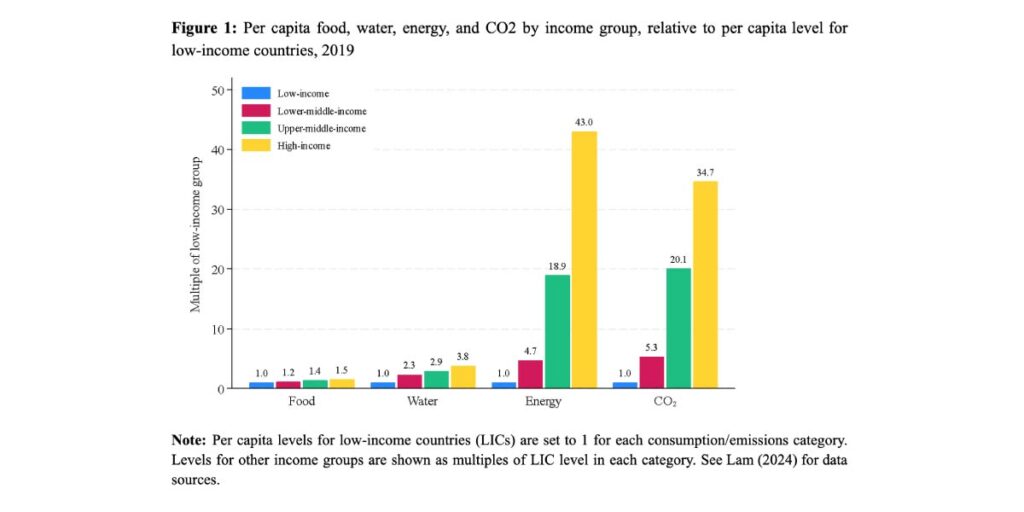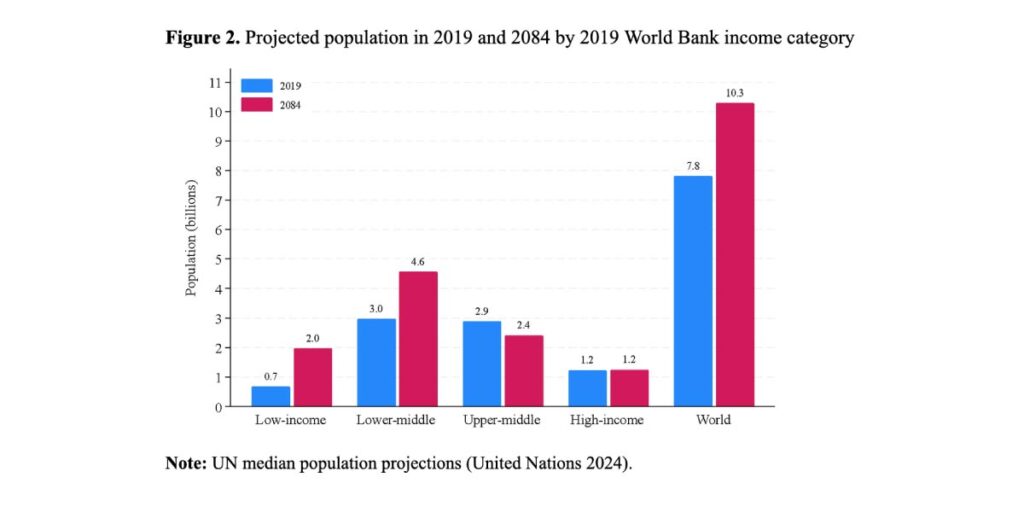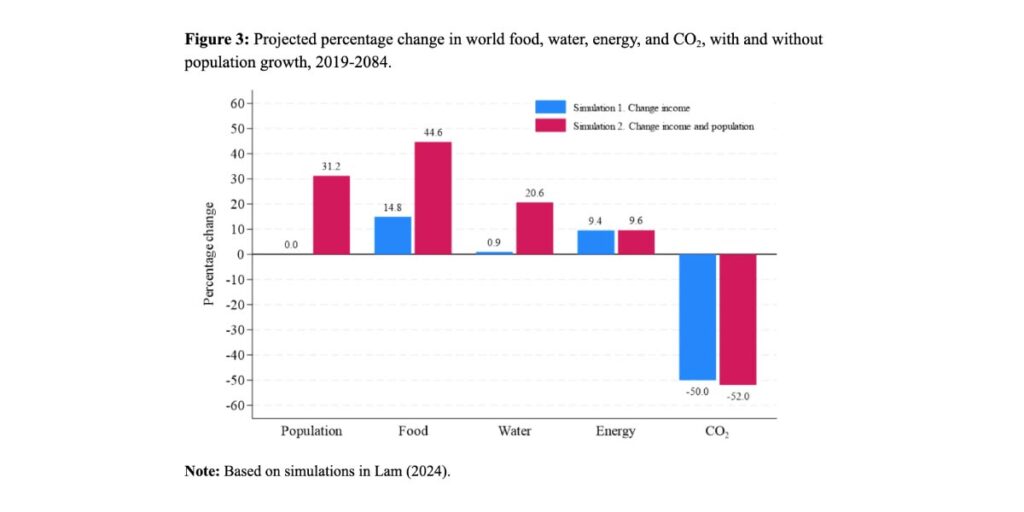David Lam looks at the resource impact of the projected 2.1 billion increase in world population by 2084. He concludes that population change will increase demand for food and water, but will have almost no effect on CO2 emissions, with population decline in higher-income countries offsetting the impact of population growth in lower-income countries.
The United Nations (2024) projects that world population will peak at 10.3 billion in 2084, up 2.1 billion from 2024. Can the world provide food, water, and other resources for 10.3 billion people? How will two billion more people affect climate change?
The demography of the next 60 years
UN projections imply that 2084 will mark the end of centuries of world population growth. Some countries, including China, are already experiencing population decline, and more will join them in coming decades. Population growth will be concentrated in countries currently classified as low-income (LICs) and lower-middle-income countries (LMICs) by the World Bank, while countries classified as upper-middle-income (UMIC) and high-income countries (HIC) will collectively experience significant population decline. Most population growth will be in Africa, a shift from population growth being concentrated in Asia. While Africa is projected to continue growing throughout the century, Asia’s population is projected to peak in 2054. China is projected to lose 600 million people between 2024 and 2084.
Past population growth and resource challenges
Looking at the last 60 years, it is encouraging that food production has increased faster than population in all regions, and we have not experienced significant shortages in non-renewable resources (Lam 2023, 2024). The history of water and CO2 emissions is less encouraging, with declining water levels in many aquifers and climate change threatening to undermine progress in all areas. A key factor is that food and non-renewable resources are highly responsive to market signals, while water and greenhouse gas emissions are sectors in which market signals are less effective.
Simulating the impact of future population growth
Projections of future consumption depend on the relationship between consumption and income. Figure 1 shows per capita food, water, energy, and CO2 by income group. For each consumption category, the per capita value for LICs is set to 1.0, with values for other income groups shown relative to that. The income gradient for food is relatively flat, with HICs having per capita food consumption 1.5 times higher than LICs. The income gradient for energy and CO2 is much steeper. Per capita CO2 emissions are 35 times higher in HICs than in LICs.

Figure 2 shows the large differences in population growth across income groups. The combined population of LICs and LMICs is projected to increase 2.9 billion from 2019 to 2084, while that of UMICs and HICs is projected to fall 0.5 billion. (I use 2019 as the baseline for simulations to avoid the disruptions associated with COVID-19). Taking Figures 1 and 2 together, coming decades will see a large shift in population from countries with high consumption and emissions to countries with low consumption and emissions.

I use two simulations to analyze future consumption and emissions. Simulation 1 asks what would happen to world food, water, energy, and CO2 in 2084 if each country’s population remains at 2019 levels, but there is income growth and associated changes in consumption and emissions. Simulation 2 asks what would happen if each country followed UN median population projections, with income and consumption following the same path as Simulation 1. Lam (2024) details assumptions for factors such as income growth, declines in energy intensity of income, and declines in carbon intensity of energy, drawing on existing literature.
Figure 3 summarizes the results, showing the percentage change in world population, food, water, energy, and CO2 for 2019-2084 for the two simulations. Income growth causes a modest 15% increase in world food consumption and almost no increase in world water consumption in the absence of population growth (Simulation 1). When population growth is added (Simulation 2), food increases by 45% and water by 21%. In contrast, adding population growth has almost no effect on energy and CO2 emissions relative to the simulation without population growth. Adding population growth slightly increases the decline in global emissions from 2019 to 2084, from -50% to -52%.

Different assumptions about future declines in emissions per dollar of GDP would affect the magnitude of the decline (or increase) in global emissions. But it would still be the case that projections with and without population change would be almost identical. This is because declining populations in UMICs and HICs, with high per capita emissions, offset the impact of population growth in low-emission LICs and LMICs.
It should be noted that population growth does increase CO2 emissions in poorer countries in Simulation 2. Emissions would decline in both LICs and LMICs from 2019 to 2084 in the absence of population growth. Population growth reverses that trend from a 1.1% annual decline in CO2 to a 0.4% annual increase in LICs. Slower population growth in LICs and LMICs would lead to faster declines in emissions, although the magnitude of the effect is mitigated by the low emission levels in those countries. If there were zero population growth in LICs and LMICs, leaving UMICs and HICs to follow UN median projections, global CO2 emissions would be 15% lower in 2084 than is projected in Simulation 2.
The surprising bottom line is that the net effect of projected population changes over the next 60 years is an almost neutral impact on CO2 emissions, despite the addition of over 2 billion people. The emission-increasing effect of population growth in low-emission lower-income countries is offset by the emission-reducing effect of population decline in higher-income countries.
References
Lam, David (2023). Has the World Survived the Population Bomb? A 10-year Update. Population and Environment 45(10). https://doi.org/10.1007/s11111-023-00422-7.
Lam, David (2024). The Next 2 Billion: Can the World Support 10 Billion People? Population and Development Review. https://doi.org/10.1111/padr.12685.
United Nations (2024). World Population Prospects 2024. United Nations Department of Economic and Social Affairs, Population Division.


